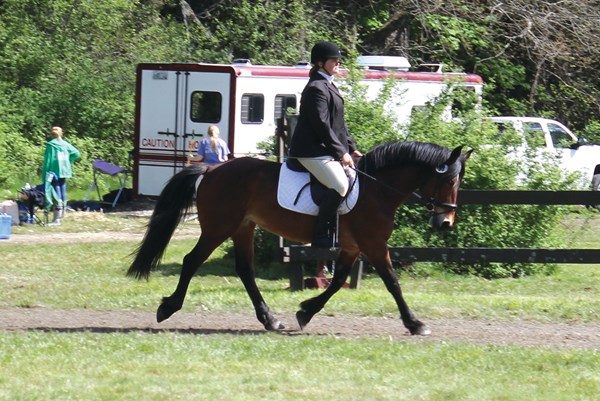This is Aly Werth and her 8-year-old, Morgan/draft-cross mare, Blue. The two are competing at Training Level this year. In this photo, Aly is sitting on her mare in a fairly good balance. From this photo, my impression is that she doesn’t get very much in her horse’s way. She is almost lined up well enough from her shoulder to hip to heel, but to be better, I’d like to see her lower leg positioned farther back and her knee a bit more down. Her hands are carried too low and that’s most likely an effort to keep Blue’s head position from getting too high.

I am guessing this is the down beat (or bottom of the rise) of the posting trot. Even though she’s OK on the down beat, I think there will be a problem when Aly is at the highest point in each rise of her posting trot because her knee is too far out in front of her. And because Blue is too much on her forehand and her hind legs aren’t coming far enough under her body, so it might not be easy for Aly to think about posting with enough thrust in her pelvis to get to the top of the rise. When done correctly, each rise should look like a straight line from Aly’s shoulder to her hip to her knee. She will have to try her best to get her hip in that line every time she rises.
From just a single snapshot, I have to guess on a few things here, but I think with Blue being too much on her forehand, she is probably also trotting too fast. I think she is taking Aly around the ring instead of the other way around. This kind of trot often makes riders post about half as high as they should (the pelvis should get all the way to the top of the pommel) as a way to try to slow down their horse. However, by cutting the posting distance in half, the rider reduces the time between each half as well. This actually increases the rider’s rhythm, causing the horse to also have a quick tempo. Instead, Aly needs to try to keep her horse’s tempo on her terms by insisting that her mare respond to the amount of time that Aly takes to make the entire length of posting completely to the top. If Aly can get to the point where she can really get distinctly to the top of the rise every time and then have Blue wait for the aid from her leg to go forward, it would improve the overall balance.
With those changes in place, there might not be as much tendency for Aly to put her hands so low. As Aly’s sense of slowing Blue’s trot with her posting and then sending her forward from her leg grows, Blue’s balance is likely to improve. It will move farther backward in her torso and less on her forehand. If Blue had her balance farther back, she could be freer in her shoulder and wither could be lift more. That would make it possible to keep her head and neck reaching forward and out from the wither and more in self-carriage. It looks like Aly holds the rein in her middle finger and it should be in her ring finger on both sides. Her fingers should remain closed enough to keep the tips of her fingers touching the butt of her hand. Additionally, her whip is carried slightly too high for a neutral position.
I would also like to see Blue’s mane braided for competition. It would create a more polished and elegant picture. Even if it is only a schooling show, I think it is good to practice the whole routine, and I think the horses recognize the difference in the preparation when they are braided. The last tip I can give Aly is that a pair of gloves would finish her turnout.











